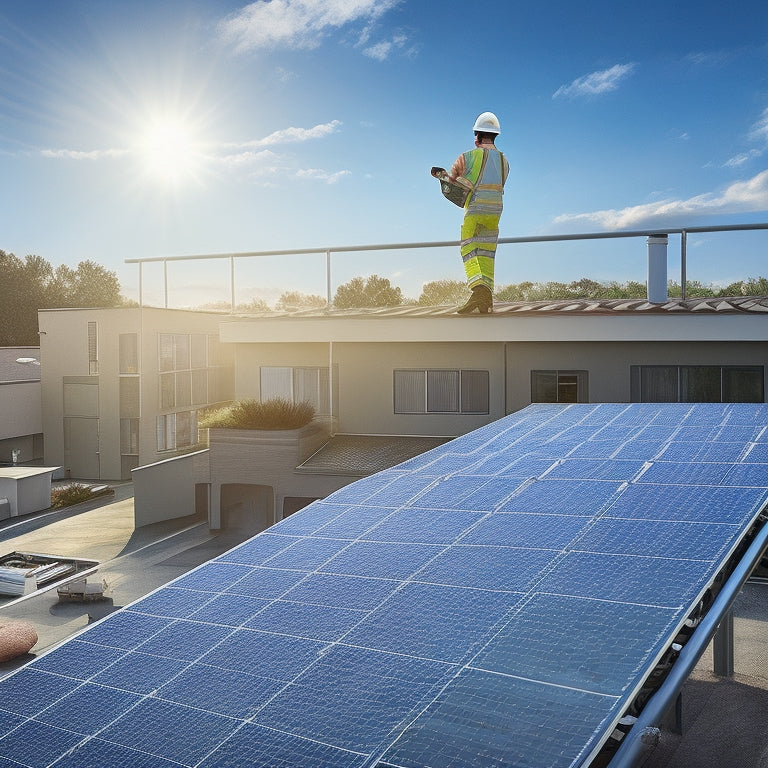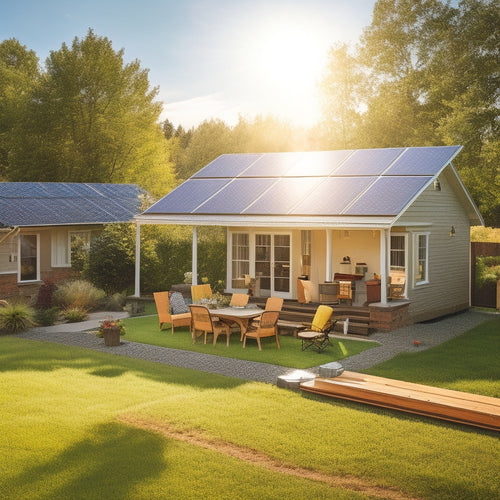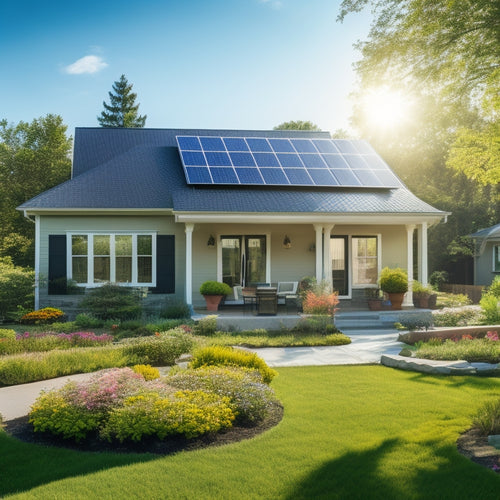
5 Essential Steps for Installing a Solar Panel System
Share
You're about to install a solar panel system, and it's essential to get it right. First, assess your energy needs by calculating your total energy consumption and identifying your energy goals. Next, choose the right equipment, including solar panel type and inverter, based on efficiency, durability, and warranty. Then, prepare your roof structure by evaluating its support capacity and condition, and taking action on any damages. After that, install the solar panels, ensuring secure connections and compliance with local building codes. Finally, connect to the grid by installing a bi-directional meter and participating in net metering programs, and you'll be on your way to maximizing your solar panel system's efficiency and savings - with the right guidance, every detail can be optimized.
Key Takeaways
- Assess energy needs by calculating total energy consumption, identifying peak sun hours, and defining energy goals to ensure proper system sizing.
- Choose the right equipment by selecting suitable solar panels and inverters based on efficiency, durability, and warranty, considering budget and installation constraints.
- Prepare the roof structure by assessing its capacity, replacing damaged or worn-out materials, and evaluating features like shingles, rafters, and flashing.
- Install the solar panels by securing the mounting system, inspecting panels, and ensuring secure connections, meeting local building codes and manufacturer instructions.
- Connect to the grid by installing a bi-directional meter, participating in net metering programs, and tracking net energy production to maximize savings and efficiency.
Assessing Your Energy Needs
To determine the size of the solar panel system you need, you must first evaluate your energy requirements. This involves calculating your total energy consumption, which includes your daily energy usage and any seasonal variations. Review your past utility bills to get an accurate depiction of your energy consumption patterns.
You'll want to identify the total kilowatt-hours (kWh) used per month, as well as the peak sun hours in your area.
Next, consider your energy goals. Are you looking to power your entire home or just a portion of it? Do you want to reduce your reliance on the grid or achieve energy independence? Knowing your energy goals will help you determine the size of the solar panel system you need.
Additionally, research local solar incentives, such as tax credits or rebates, which can impact the overall cost of your system. By accurately evaluating your energy needs, you can guarantee that your solar panel system is properly sized to meet your energy requirements, maximizing its efficiency and effectiveness.
Choosing the Right Equipment
With your energy needs assessed, you're ready to select the right equipment for your solar panel system. You'll need to choose the right solar panels, inverter, and mounting hardware to guarantee peak performance and efficiency.
When selecting solar panels, consider the type that best suits your energy needs and budget. Monocrystalline, polycrystalline, and thin-film solar panels are the most common types, each with their own advantages and disadvantages.
Monocrystalline panels offer high efficiency, while polycrystalline panels provide a more affordable option. Thin-film panels are ideal for large-scale installations.
Inverter options are also essential, as they convert DC power from the solar panels to AC power for your home. String inverters, microinverters, and power optimizers are popular choices, each with their own strengths and weaknesses.
String inverters are cost-effective, while microinverters provide greater flexibility and monitoring capabilities.
Carefully evaluate your options, considering factors like efficiency, durability, and warranty, to guarantee you choose the right equipment for your solar panel system.
Preparing Your Roof Structure
As you prepare to install your solar panel system, evaluating your roof's structural integrity becomes essential, since it will bear the weight of the panels and withstand various environmental conditions.
You'll need to assess the condition of your roof materials, such as shingles, tiles, or metal, to verify they can support the added weight of the solar panels. Check for signs of wear, damage, or decay, and consider replacing them if necessary.
Here's a rough guide to help you evaluate your roof's structural integrity:
| Roof Feature | Condition | Action Required |
|---|---|---|
| Shingles | Damaged or missing | Replace before installation |
| Rafters | Rotted or sagging | Repair or replace before installation |
| Flashing | Damaged or corroded | Replace before installation |
| Roof Pitch | Too shallow (<3:12) | Consult a professional for special installation |
Installing the Solar Panels
You've confirmed your roof structure can support the solar panel system; now it's time to focus on the installation process. Based on your site evaluation, you've determined the ideal placement and orientation of your solar panels. Make sure you have all necessary installation permits before proceeding.
Begin by securing the mounting system to your roof, following the manufacturer's instructions. Next, carefully unpack and inspect the solar panels for any damage. Install the panels onto the mounting system, taking care to maintain a secure and even connection. Verify the panels are properly aligned and securely fastened.
Throughout the installation, refer to your site evaluation to verify the system is installed according to plan. Double-check all electrical connections and wiring, making certain they meet local building codes and safety standards.
Connecting to the Grid
Plug into the power of the grid by connecting your solar panel system to the existing electrical infrastructure. This vital step enables you to sell excess energy back to the utility company and offset your energy costs.
To establish a grid connection, you'll need to install a bi-directional meter that measures both the electricity you produce and consume. This meter will track the net amount of energy you're producing, allowing you to participate in net metering programs.
Through net metering, you can sell excess energy to the grid and receive credits on your utility bill. When your system produces more power than you're using, the excess is fed back into the grid, and you'll receive credits for the energy you're contributing.
These credits can then be used to offset your energy costs during periods of low energy production, such as at night or on cloudy days. By connecting to the grid, you'll be able to maximize your solar panel system's efficiency and save even more on your energy bills.
Frequently Asked Questions
Can I Install Solar Panels on a Rented Property?
You can install solar panels on a rented property, but you'll need your landlord's permission and a tenant agreement. Consider a solar lease, which allows you to benefit from solar energy without owning the system, making it a win-win for both you and your landlord.
How Long Does a Solar Panel Warranty Typically Last?
You're likely aware that solar panels can last up to 40 years or more; impressively, most manufacturers offer a warranty that matches that lifespan, providing 25-30 years of warranty coverage with varying warranty terms to guarantee your investment is protected.
Do Solar Panels Work During Power Outages?
You're wondering if solar panels work during power outages? Typically, they don't, as they're tied to the grid and shut off during outages for safety reasons. However, you can invest in power outage solutions like battery storage to maintain solar panel efficiency and keep the lights on.
Can I Add More Panels to My Existing System Later?
You can easily upgrade your existing system by adding more panels, increasing your system's capacity and generating more power; this system expansion allows you to tap into additional capacity, giving you more control over your energy output.
Are Solar Panels Resistant to Hail and Extreme Weather?
Your solar panels are like a fortress, standing strong against the storm. Rest assured, they're designed to withstand hail damage and extreme weather conditions, ensuring weather durability that's as tough as you are, so you can capture the power you need.
Conclusion
You've made it! You've successfully installed a solar panel system that will save you a small fortune on energy bills and catapult you into the elite ranks of eco-warriors. Your carbon footprint will shrink to near zero, and your sense of satisfaction and accomplishment will soar to stratospheric heights. You'll be the envy of your neighbors, the talk of the town, and the glory of the planet. Congratulations, you've just changed your life - and the world - for the better!
Related Posts
-

Steps to Prepare for Solar Installation
To prepare for solar installation, start by evaluating your current energy consumption and future needs to determine ...
-

Integrating Smart Technology for Energy Savings
Integrating smart technology into your home is a transformative factor for energy savings. Smart thermostats give you...
-

Affordable Solar Panels for Home Use
Affordable solar panels offer you a smart way to cut down on energy costs while promoting sustainability. With govern...


